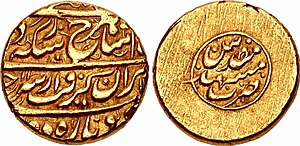
Back شاهرخ ميرزا Arabic شاهرخ ميرزا ARZ Şahrux şah Azerbaijani شاهرخمیرزا AZB Šáhruch Czech Schah Ruch (Afscharide) German Σαχρόχ Σαχ Greek Shahroj Mirza Afshar Spanish Shahrokh Xah Basque شاهرخشاه Persian
| Shahrokh Shah شاهرخشاه | |
|---|---|
| Shah | |
 Coin minted in the name of Shahrokh Shah at Mashhad, between 1750–1755 | |
| Ruler of Khorasan | |
| 1st Reign | 1 October 1748 – 14 January 1750 |
| Predecessor | Adel Shah |
| Successor | Suleiman II (Safavid dynasty) |
| 2nd Reign | 20 March 1750 – 1796 |
| Predecessor | Suleiman II |
| Successor | Agha Mohammad Khan Qajar (Qajar dynasty) |
| Born | March 1734 |
| Died | 1796 (aged 62) Damghan |
| Spouse | Unnamed Jalayir wife |
| Issue | Nasrollah Mirza Nader Mirza |
| Dynasty | Afsharid dynasty |
| Father | Reza Qoli Mirza Afshar |
| Mother | Fatemeh Soltan Begom |
| Religion | Twelver Shia Islam |
Shahrokh Mirza (Persian: شاهرخمیرزا; 1734–1796), better known by his dynastic title of Shahrokh Shah (شاهرخ شاه) was the Afsharid king (shah) of the western part of Khorasan (corresponding to the present-day Khorasan Province)[1] from 1748 to 1796, with a two-month interruption. A grandson of the Iranian conqueror Nader Shah (r. 1736–1747), Shahrokh was the son of Reza Qoli Mirza Afshar and his Safavid wife Fatemeh Soltan Begom, who was the sister of Tahmasp II, the penultimate Safavid shah of Iran. Shahrokh's half-Safavid descent made him stand out amongst his Afsharid relatives, and was used to bolster the legitimacy of his grandfather. After the assassination of Nader Shah in 1747, his nephew Ali-qoli Khan (who assumed the regnal name Adel Shah), ascended the throne in Mashhad and had all of Nader Shah's descendants in fortress of Kalat massacred. Shahrokh was spared in case his Safavid lineage would come to use, and was instead kept in the fortress as a prisoner. While Adel Shah was battling his rebellious younger brother Ebrahim Mirza, a party of Turkic, Kurdish, and Arab tribal leaders took advantage of his absence and installed Shahrokh on the throne. Both Adel Shah and Ebrahim were eventually defeated and killed, but Shahrokh was not long afterwards overthrown by a party of dissident tribal leaders, who installed the Safavid pretender Mir Sayyed Mohammad (who assumed the regnal name of Suleiman II) on the throne. Shahrokh was soon blinded at the instigation of Mir Alam Khan Khuzayma and other leading nobles, much against Suleiman II's will.
A group of conspirators led by the Turkic tribal leader Yusuf Ali Khan Jalayir eventually deposed Suleiman II and restored Shahrokh to the throne.
- ^ Perry 1991, p. 71.